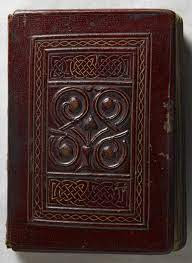It is a "pocket-sized" Gospel of John from the 8th century, only 5.4' x 3.6" with 94 vellum folios (pages) and a leather binding/cover over wooden boards (pictured here). It was kept with other relics of St. Cuthbert at Durham Cathedral. When King Henry VIII dissolved the monasteries after 1536, it traveled probably through many hands until it finally landed at Stonyhurst College in Lancashire. It was on long-term loan to the British Library due to its value as an early example of book binding and its association with the Anglo-Saxon saint, Cuthbert of Lindisfarne. Eventually the British Library purchased it, so it is now part of their permanent collection. It is intended to be displayed alternately between the British Library and at Durham.
The reason we have such a well-preserved book is because it was not known to exist for several centuries. Cuthbert died in 687 CE; his coffin was moved more than once to protect it from Viking invasions. In 1104, the coffin was moved to Durham Cathedral for re-burying, and was opened for a glimpse of the venerable saint. That was when, four centuries after the death of Cuthbert, the gospel was found inside the coffin!
Initially thought to be Cuthbert's personal Gospel, it is now thought that it was placed in the coffin to be with him a few years after he died. Based on the form of writing, it is presumed to have been written between c.700 and c.730 and slipped into his coffin at a later date.
Who was Cuthbert? Why was he so important that someone wanted to give him a "gift" of a Gospel even after he died? And important enough that his coffin was moved several times to keep it safe? We'll take a look at him and his accomplishments next time.

No comments:
Post a Comment
Note: Only a member of this blog may post a comment.